The first Constitution of the U.S. was ratified in 1781, the Articles of Confederation as it was called. At this time, America was still fighting Britain for their freedom. The American government was comprised of only one branch, the legislature. Instead of a House of Representatives and the Senate, there was one the Congress of the Confederation. In fact, there wasn’t an executive or judicial branch. Each state was like its own country because of the way the government was run.
America finally won its freedom two years later in 1783. Everyone came to realize that they needed a much stronger and more stable government to keep the country going. Alexander Hamilton, New York lawyer, politician, and war hero, requested a constitutional convention be held in 1786. The following February, the Confederation Congress endorsed Hamilton’s idea. Delegates from all of the thirteen states were invited to meet in Philadelphia for the convention.
In Philadelphia on May 25, 1787, the Constitutional Convention began. It was held in the same building the Declaration of Independence had been signed, Independence Hall, or Pennsylvania State House as it was called. Though the meetings were to be held in secret with no outsiders or reporters allowed, James Madison took detailed notes on the event. In 1837, after Madison had passed away, his wife, Dolley Madison, sold his notes and papers to the government.
55 delegates were in attendance from 12 different states. Rhode Island had opted out of the event in fear that their economy would be ruined by adopting a stronger government system. By a unanimous vote, George Washington was president of the convention. Many figures withholding high political titles at the time were not in attendance of the convention however, Thomas Jefferson, John Adams, and John Jay being only a few.
Congress had issued the delegates the task of amending the already in place Articles of Confederation. Instead, the delegates began debating new forms of government for their new country. Debates continued through the summer. The delegates finally agreed on three branches of government – the legislative, judicial, and executive. Each branch was designed in a way that no such one would have too much more power than the others.
One of the main issues the delegates could not agree on was how many representatives each state would have in congress. While small states believed each state should have the same number, larger states believed it should be based on population. It was finally agreed upon that each state would have an equal number of representatives in the upper house, or Senate. The lower house, or House of Representatives, would be based on the population of each state.
Slavery was yet another topic that was debated upon often. The delegates from the southern states believed that each state should make that decision, not the federal government. The northern states agreed with this, as many of them had already banned slavery. This was also when the decision was made that slaves would amount for only three-fifths of one person. That way slaves would not amount to too much of the population and cause greater numbers of representatives from the south.
The final constitution had been finished by September of 1787. Alexander Hamilton, James Madison, William Samuel Johnson, Gouverneur Morris, and Rufus King were chosen to draft the document. George Washington became the first delegate to sign the constitution of September 17, 1787. Only 39 of the 55 delegates signed the document. From there, nine states would have to ratify it.
During the period when the constitution was awaiting ratification, James Madison, Alexander hamilton, and John Jay wrote 85 essays titled The Federalist Papers. Their essays spoke of the new government and how it would work and promoted ratification.
Delaware, Pennsylvania, New Jersey, and Georgia all ratified the document quickly, starting on December 7, 1787. Many of the other states were against the constitution, Massachusetts especially. One of the main reasons many states would not sign it was because it did not mention the right to religion, speech, and press. When it was assured that these would be put in place as amendments once the constitution was ratified, Massachusetts and many others agreed to sign it. New Hampshire was the final state to ratify it on June 21, 1788, after Massachusetts, Maryland, and South Carolina.
The new government would officially begin March 4, 1789. George Washington was elected as the first president on April 30, 1789. Though nine states had already ratified it, Virginia and New York soon did as well. Then, the first U.S. Supreme Court session began on February 2, 1790. On May 29, 1790, Rhode Island became the thirteenth and final state to ratify the constitution.
James Madison proposed 19 amendments to the new constitution after being elected to the house of Representatives in 1789. Congress voted for 12 of Madison’s proposed amendments. Then they would await ratification. Two of these amendments did not get ratified, but 10 did on December 10, 1791. These 10 original amendments were titled the Bill of Rights. One of these amendments would later be passed, but not until 1992!
Madison would be later known as the “Father of the constitution” because he not only helped draft the document, he also proposed nineteen amendments and helped to promote the document. constitution of the U.S.constitution of the U.S.



